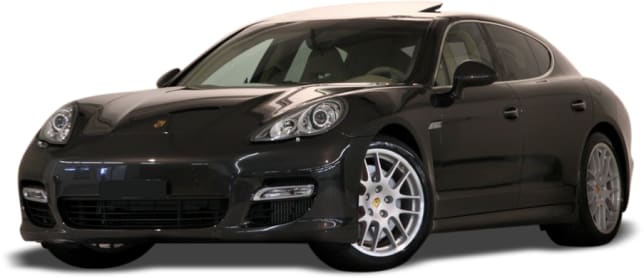
Porsche Panamera 2010 Review
- Porsche Panamera
- Porsche Panamera 2010
- Porsche Panamera Reviews
- Porsche Reviews
- Porsche Coupe Range
- Porsche Sedan Range
- Coupe
- Sedan
- Porsche
- Prestige & Luxury Cars
- Family Cars
- Sports cars
You'd nearly have to be a trainspotter to pick the differences between the new Porsche Panamera V6 and its V8 sibling. At least from a distance.
But if you look closely, the black brake calipers might give it away – the V8 has yellow calipers – or the two single exhaust tips where the eight has doubles. There is a different wheel design and a bit of black edging on the side window trims. And that’s about it.
But it’s a clear giveaway that there are two less cylinders under the bonnet when you hear the engine, which is a wide-angled V6 developed independently by Porsche rather than being sourced from parent brand Volkswagen like the six in the Cayenne SUV. Incorporating lighter component materials such as aluminium and magnesium, the aim of the engine is to give enough power to satisfy while still trimming weight and fuel economy.
Mechanical
What you get is a 3.6-litre V6 mated to a seven-speed PDK (Porsche for twin-clutch, slick autoshifter with paddles on the steering wheel) driving either the rear wheels or all four. The engine develops 220kW at 6200rpm (peak is 6700) and 400NM of torque at 3750rpm, with the torque curve flattens out from about 2500rpm up to 5000rpm to give great mid-range response.
Those totals are 74kW and 100Nm less than the 4.8-litre V8, but – helped by stop-start technology that temporarily cuts the engine when you halt – it’s also 2.8 litres more economical at 9.3L/100km, and with similar exhaust payoff at 218g/km compared to the eight’s 293g/km.
Naturally, there’s also about 20 per cent difference in 0-100km/h performance, with the eight ahead at 5.6secs over the V6’s 6.3secs.
But it carries just about everything else that’s important. The PDK will come as standard, as will the PASM active and changeable suspension damping system, and the raft of traction, stability and braking controls.
Pricing
As the new entry levels – making the Panamera a five-model range – the two-wheel drive starts from $193,000 and the all-wheel drive from $204,000. They slot in under the Panamera S at $270,000, the 4S at $282,000 and the Turbo at $364,000.
Porsche Australia is currently selling around 12 per month, and expect the V6 models to boost that figure considerably, possibly growing to double. “We’ve already had strong inquiry,” spokesman Paul Ellis says. “We think the V6 will be more than 20 per cent – we hope it will be higher… maybe up to half.”
Fit-out and equipment
Apart from the two extra cylinders – and the extra power and performance that come with them – you don’t miss out on much by going for the ‘entry level’ Panamera rather than the V8.
Strike out the tyre pressure monitoring system, bi-xenon headlights, heated front seats, and settle for steel suspension rather than the standard air set-up on the way for the big brother, and for eight-way seat adjustment rather than 14-way – and that’s pretty much the lot.
There’s the same snug leathered cockpit with a centre stack that seems to be encrusted with gadget controls – thankfully intuitive – electric everything, and reasonable room in the back for two adults. Perhaps smallish ones, granted. But it’s a true back seat rather than a parcel rack kitted out with seat-belts.
Driving
Unless you measure your life in split seconds ahead of everybody else at the traffic lights, the difference in performance between the V6 and the V8 is not going to matter a great deal.
The new arrival is still quick, eager and strong all the way. More than enough for most people, and more than enough for most of it to remain untapped on Australian roads anyway. Those who think there’s no substitution for capacity might be surprised.
And helped by being a bit lighter – and by being more centred with the V6 weight further back in the engine bay than the bigger eight, giving a front: rear ratio of 52:48 – the new car seems more nimble, more sprightly.
The steering is sharp but feels oddly a little too light around town, however it weights up meatily once you start to hit higher speeds. And the all-wheel drive we tested held its ground through a series of curving little hill roads.
Switching the suspension over the Active Sports put more steel into everything, with the gears holding out longer and the dampers getting tenser ... perhaps a little too tense over some cracked and crumbled town streets.
But there's little music for the ears unless you really plant your foot, when admittedly the exhaust does surrender a passable snarl. On which note, you have to wonder if potential buyers for this car are really keen on waking up the street in any case.
But those who want to feed their inner hoon will be delighted to know there's a sound-boosting exhaust option on the way next year, that promises to lift the decibels nearer to unsociable levels.
In some ways that would spoil the car. Like the V8, it's a luxurious and comfortable grand cruiser. And we think we might just prefer it to the bigger bruiser. Unless you really want to spend that extra $70,000-odd, you’d be hard pressed to pass up the six.
Porsche V6 Panamera and V6 Panamera 4
Price: from $193,000 ($204,000)
Body: Four-door sedan
Seats: Four
Engine: 3.6-litre V6
Power: 220kW/6200rpm
Torque: 400Nm/3750rpm
Transmission: seven-speed PDK double-clutch gearbox, rear or all-wheel drive
Performance: 0-100km/h 6.3s, top speed 259km/h
Economy: 9.3L/km (9.6 Pan 4)
Emissions: 218g/km
Pricing guides
Range and Specs
| Vehicle | Specs | Price* | |
|---|---|---|---|
| 4S | 4.8L, PULP, 7 SP AUTO | $56,320 – 64,680 | 2010 Porsche Panamera 2010 4S Pricing and Specs |
| S | 4.8L, PULP, 7 SP AUTO | $53,900 – 61,930 | 2010 Porsche Panamera 2010 S Pricing and Specs |
| (base) | 3.6L, PULP, 7 SP AUTO | $37,620 – 44,220 | 2010 Porsche Panamera 2010 (base) Pricing and Specs |
| Turbo | 4.8L, PULP, 7 SP AUTO | $72,710 – 83,600 | 2010 Porsche Panamera 2010 Turbo Pricing and Specs |
$53,900
Lowest price, based on third party pricing data












